Slovenian Economic Mirror
Related Files:
Slovenian Economic Mirror 5/2022
Growth of domestic consumption remains high in Slovenia. The gradual easing of containment measures and the situation on the labour market with record high employment have had a positive impact on the continued growth of household consumption in the first four months. Household purchasing power is increasingly affected by rising prices, especially of energy and food, as inflation picked up in May. Construction activity also picked up significantly in the first quarter, after a long period without growth also in non-residential construction; cost pressures in the construction sector are increasing. In the export sector, which has been struggling with supply chain disruptions and rising costs for some time, growth in activity slowed and the situation was exacerbated by the war in Ukraine. Amid great uncertainty in the international environment, economic sentiment deteriorated again in May. In this issue of Slovenian Economic Mirror we also present the business results of companies in 2021, which, after deteriorating in the first year of the epidemic, improved significantly last year, also thanks to further government support measures.
Related Files:
- International environment
- Economic developments
- Labour market
- Prices
- Financial markets
- Balance of payments
- Public finance
Indicators of economic activity in the euro area
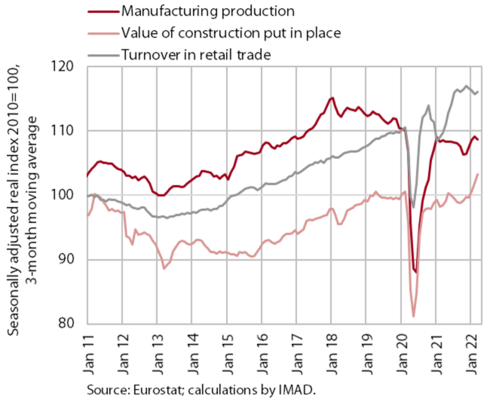
Growth in economic activity in the euro area increased slightly in the first quarter of this year and, according to the available indicators, a similar growth is likely to continue in the second quarter. Growth in the first quarter stood at 0.6% quarter-on-quarter (0.2% in Q4 2021) and 5.4% year-on-year on a low base. Private consumption in the first quarter was still dampened by containment measures, as indicated by a quarterly decline in retail trade turnover (-0.6%). Production in manufacturing was one per cent higher than in the previous quarter, whereas construction activity picked up significantly (3.7%), despite shortages of labour and materials. According to the average PMI values for April and May, growth in economic activity in the euro area in the second quarter is likely to be similar to that in the first quarter of this year. With the lifting of containment measures, services are the main contributor to growth, while growth in manufacturing activity is modest in the face of significant supply chain disruptions and inflationary pressures. The economic sentiment indicator (ESI) in the euro area remained close to the level reached in March, when it had fallen sharply due to the start of the war in Ukraine.
Forecast of economic growth in the euro area
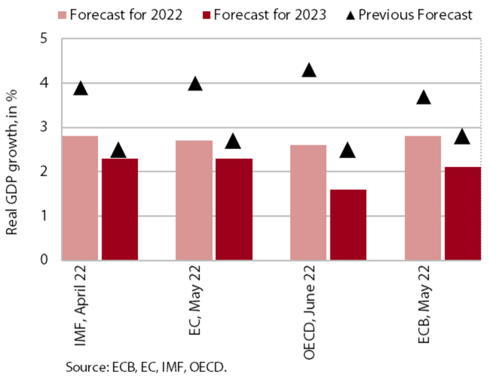
In their latest forecasts, the international institutions have revised their economic growth forecasts for the euro area significantly downwards. Economic growth will slow considerably this year, mainly due to the consequences of the war in Ukraine, and will be much weaker than expected at the beginning of the year, given high commodity prices, increasing supply chain disruptions and greater uncertainty. In February, the EC downgraded its economic growth forecast for the euro area by 1.3 p.p. to 2.7% and forecasts growth of 2.3% in 2023. The ECB and OECD also expect similar growth this year, which is expected to be boosted especially by private consumption, given favourable labour market conditions, lower accumulation of savings and measures to cushion rising energy prices. The ECB forecasts similar growth for the euro area as the EC for 2023, while the OECD’s forecast is significantly lower at 1.6%. Due to the EU embargo on Russian oil exports, the OECD forecasts much higher inflation in the euro area than other institutions (4.6% in 2023), predicting that this is likely to have a significant impact on activity. According to the ECB, euro area inflation is expected to reach 6.8% in 2022 before falling to 3.5% in 2023 as energy and food prices are set to moderate, supply chain disruptions to ease and monetary policy to normalise. The forecasts are subject to high uncertainty associated with the unfolding of the war in Ukraine, possible cut in gas supply from Russia to Europe, increasing disruptions in global supply chains, inflationary pressures, and even more rapid changes in monetary policy. The re-emergence of the COVID-19 pandemic also remains a risk.
Commodity prices

The price of Brent crude rose sharply again in May in anticipation of the EU’s decision to suspend imports from Russia. Compared to the previous month, the average dollar price decreased by 7.8% to USD 113.1 per barrel; it was up by 65.1% year-on-year (by 89.5% in EUR). Dollar prices of natural gas on the European market fell by 7.3% compared to April, while they were 235% higher year-on-year. According to the World Bank, the average prices of non-energy commodities in international markets fell in May compared to April, as prices of most non-energy commodity groups dropped. Prices of non-energy commodities were on average 14.9% higher year-on-year, prices of food and fertilisers continued to rise sharply, while prices of wood and metals and minerals fell. Rising energy prices continue to be the biggest contributor to inflation, which averaged 8.1% in the euro area in May.
GDP, Q1 2022
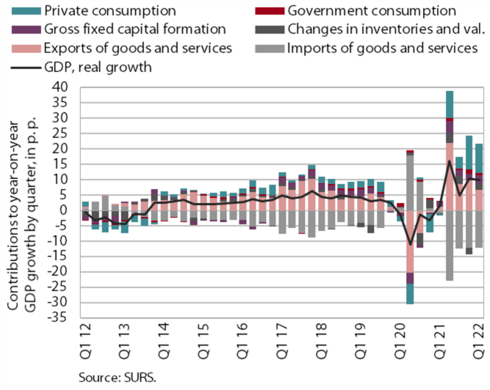
In the first quarter of this year, real gross domestic product (GDP) increased by 0.8% compared to the last quarter of 2021, which is less than in previous quarters, while year-on-year growth (9.8%) remained high, mainly due to last year’s low base. Growth in economic activity slowed, especially in the export sector, which has been struggling with supply chain disruptions and rising costs for some time, and the situation was exacerbated by the war in Ukraine. The gradual easing of containment measures and the situation on the labour market, with record employment, had a positive effect on the further growth of household spending. The purchasing power of households is increasingly affected by rising prices, especially of energy and food. In the first quarter, investment growth was also high year-on-year, with non-residential construction, residential construction and civil engineering in particular recording high growth this year. However, cost pressures and problems due to material shortages are increasing in the construction sector. Government consumption was also higher than in the same period last year, with growth mainly due to employment growth and an increase in spending on goods and services in the health sector.
Electricity consumption
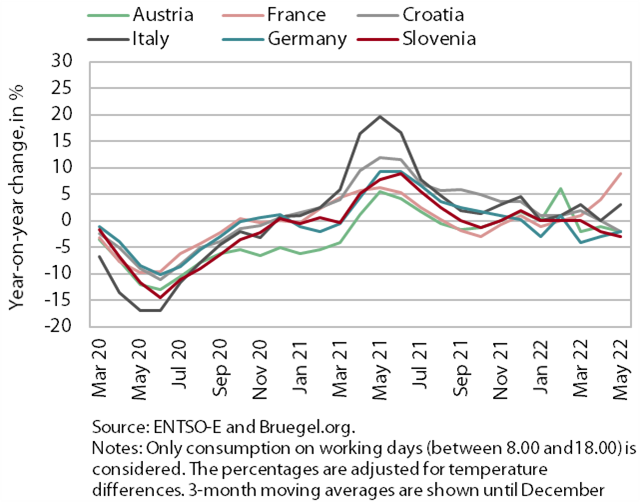
Electricity consumption in May was 3% lower year-on-year and 7% lower than in May 2019. We estimate that the lower consumption was due to both lower household and industrial consumption. Household consumption is lower due to the better epidemic situation, while industrial consumption is lower for at least two reasons. The first reason could be supply chain problems and material shortages, which, according to the survey data, worsened again at the turn of the second quarter after having calmed somewhat in the first quarter of the year. Another reason could be the current energy crisis, which has prompted some more energy-intensive companies to adjust their production. Among Slovenia’s main trading partners, consumption in May was lower year-on-year in Austria, Germany and Croatia (by 2% each), while it was higher in Italy and France (by 3% and 9% respectively). Compared to May 2019, consumption was lower in Austria (-5%), Croatia (-5%) and Germany (-3%), while consumption in France and Italy remained about the same.
Electricity consumption by consumption group

In May, industrial electricity consumption and small business electricity consumption were higher year-on-year, while they were slightly lower compared to the same period of 2019. Industrial electricity consumption was 1.8% higher year-on-year in May and small business electricity consumption was 6.7% higher. The main reason for higher consumption was last year’s restrictions of business activities in trade and services. Household consumption was 5.2% lower in May than a year ago due to the better epidemiological situation and the fact that fewer people were working from home. Compared to May 2019, small business consumption was 1.9% lower and industrial consumption was 0.5% lower, which is mainly related to the unstable situation with regards to material supply and the energy crisis. Household consumption in May was similar to the same period in 2019.
Traffic of electronically tolled vehicles on Slovenian motorways
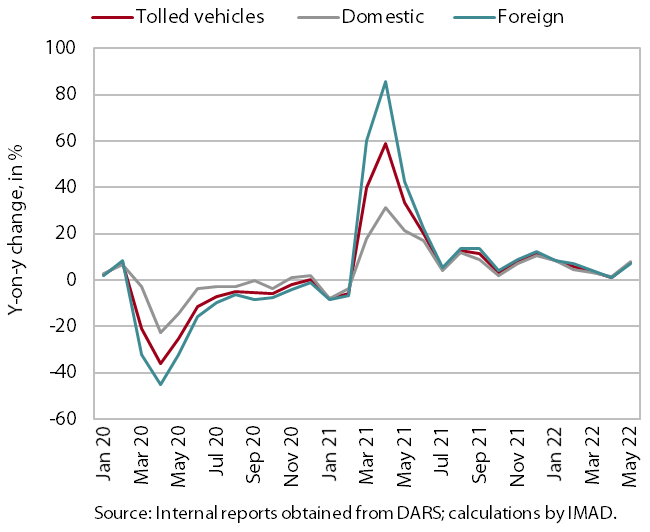
Freight traffic on Slovenian motorways was up 8% year-on-year in May. Traffic in May 2020 was a quarter lower than in May 2019 due to containment measures (and one less working day), before returning to pre-epidemic levels in May 2021. The significant increase in May 2022 was almost the same year-on-year as compared to May 2019 (7%) and is also calendar adjusted, as May had 21 working days in all three years compared. Freight traffic volumes were 9% higher in May this year than in April. The share of foreign vehicle traffic, which varies slightly from month to month, was 60% in May, 1.8 p.p. lower than in the same month before the epidemic. In the compared cumulative sums from January to May, the difference was much smaller, only 0.6 p.p., indicating that the epidemic did not lead to any significant changes in the traffic structure.
Value of fiscally verified invoices
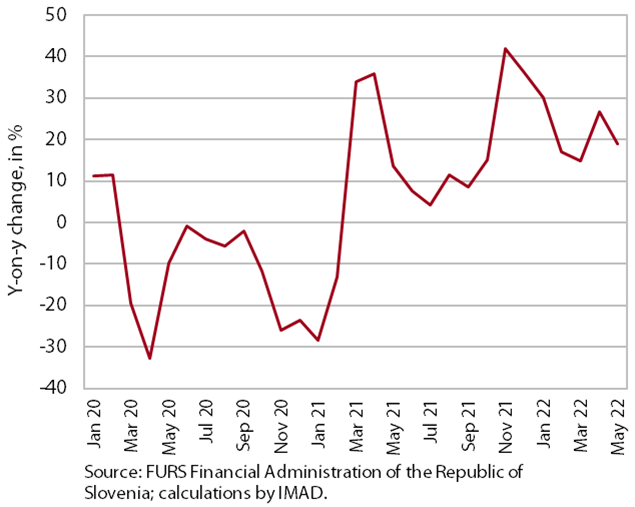
Amid high price growth in May, the value of fiscally verified invoices was higher year-on-year and compared to the same period of 2019 (by 19% and 22% respectively). Year-on-year growth slowed compared to April, mainly as a result of further lifting of operating restrictions in services in May last year. Last May, restrictions on food and beverage service activities, accommodation, sports and cultural events, and competitions were gradually (and sometimes only partially) lifted. As a result, the year-on-year growth in the value of fiscally verified invoices in accommodation and food service activities fell significantly in May compared to April, but turnover was still more than doubled. Turnover growth also declined year-on-year in cultural, entertainment and sports services (to 52%) and in trade (to 13%).
Trade in goods – real
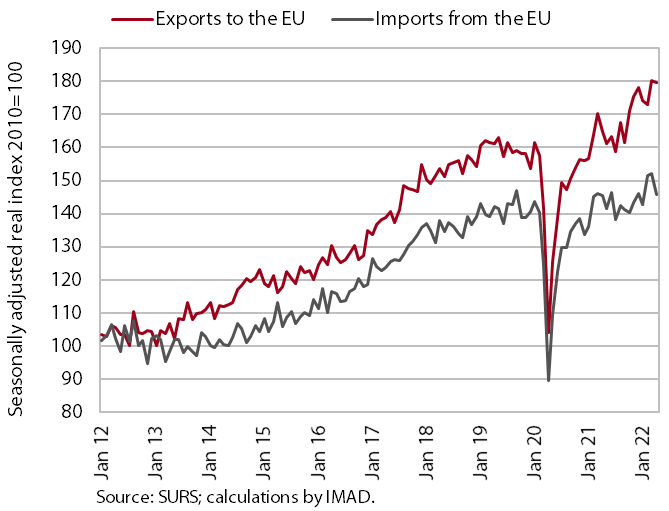
Trade in goods with EU Member States declined at the beginning of the second quarter; uncertainty is growing. The decline in real exports to EU Member States (seasonally adjusted) was largely influenced by increasing uncertainty in Slovenia’s main trading partners related to supply chain disruptions, rising inflation and the continuation of the war in Ukraine. After several months of growth, imports from EU Member States also fell sharply in April. The high level of uncertainty in the international environment has significantly affected sentiment in export-oriented activities in recent months, as export expectations and orders continued to decline in May.
Trade in services – nominal
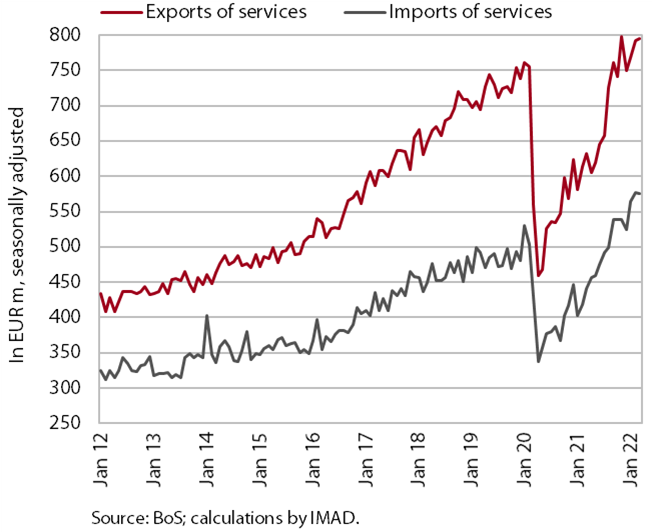
Trade in services increased in the first quarter compared to the previous quarter (seasonally adjusted), but its current monthly growth slowed in March. Favourable quarterly developments continued in trade in transport services and tourism-related services. Among the main services, trade in construction services and administrative and support service activities was lower than in the previous quarter and has been subject to strong fluctuations in recent months. In the first quarter of 2022, total trade in services exceeded pre-epidemic levels, with imports of services recovering faster than exports. Trade in most main groups of services (transportation, construction, ICT, and administrative and support services activities) has been well above comparable pre-crisis levels for several quarters. Despite the recovery, pre-crisis levels have not yet been reached by services that have declined sharply during the epidemic and have also been the most affected by the containment measures (trade in tourism-related services and trade in personal, cultural and recreational services).
Production volume in manufacturing
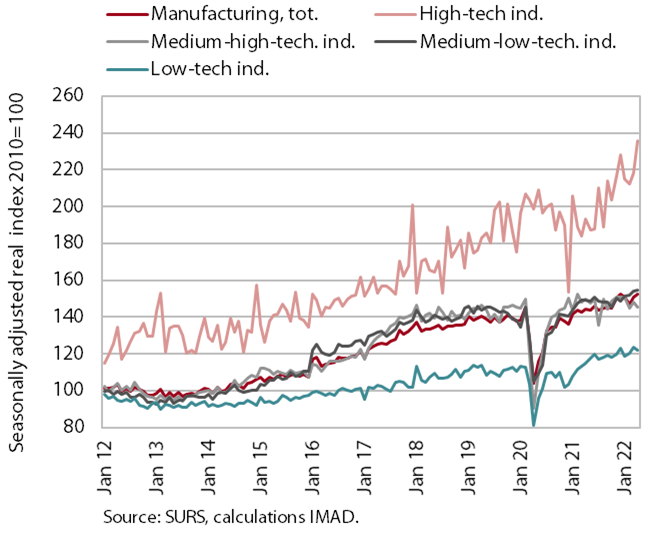
Manufacturing production strengthened somewhat in April after growth slowed in the first quarter of this year. The strongest increase was in high-technology industries, and, though more modest than in previous months, in medium-low-technology industries. Production in low- and medium-high-technology industries declined. In the latter, production in the first four months was lower than in the same period last year, mainly due to motor vehicle manufacturing (mainly the impact of a drop in production at a major car manufacturer due to the difficult situation in the automotive market).
Activity in construction
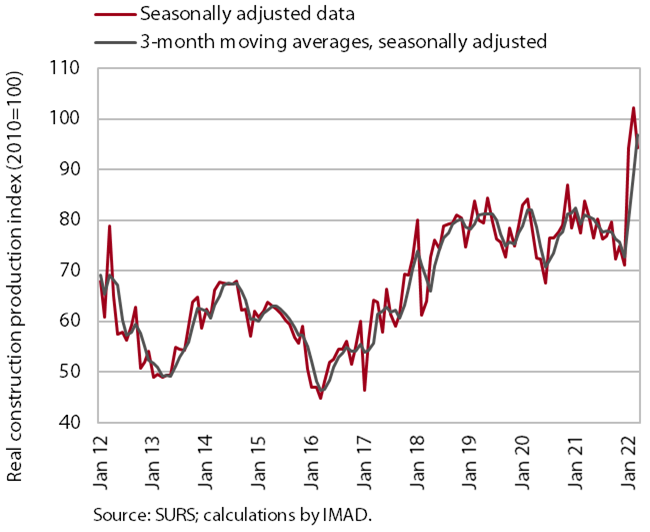
According to figures on the value of construction work put in place, activity in construction increased in the first quarter. After a gradual decline in 2021, the value of construction put in place increased at the beginning of 2022 and was 12.3% higher in March than a year ago. After a long period without growth, activity in non-residential construction recorded a strong increase in the first quarter (this was also the construction segment to have contracted most markedly last year). Activity also increased in the construction of residential buildings and in civil-engineering works, while it contracted slightly in specialised construction activities.
Cost pressures continue to intensify. The implicit deflator of the value of construction put in place (used to measure prices in the construction sector) further increased to 17.6% in March, the highest level in 20 years. According to data on business trends in construction, high material costs were reported as a limiting factor by more than 70% of companies in April, while material shortage was reported by more than 40% of companies. The values of both indicators increased sharply over the past year and reached their highest levels in 20 years in April.
Turnover in trade

In the first quarter, turnover in trade increased in most sectors. Growth was the highest in wholesale trade, where turnover increased after a sharp decline in December. Compared to the last quarter of 2021, turnover was also higher in retail trade, whose dynamics in recent months has been determined by sharp fluctuations in real turnover from the sale of automotive fuels. With the lifting of the recovered/vaccinated/tested rule, the sales of non-food products also increased, up 14% year-on-year on the low base last year. Sales of food, beverages and tobacco products were slightly lower than a year ago, stagnating in recent months but falling significantly in April, according to preliminary data. Turnover in the sale of motor vehicles fell for the second quarter in a row and was down 8% year-on-year. According to preliminary data, turnover increased slightly in April but still remained low.
Turnover in market services
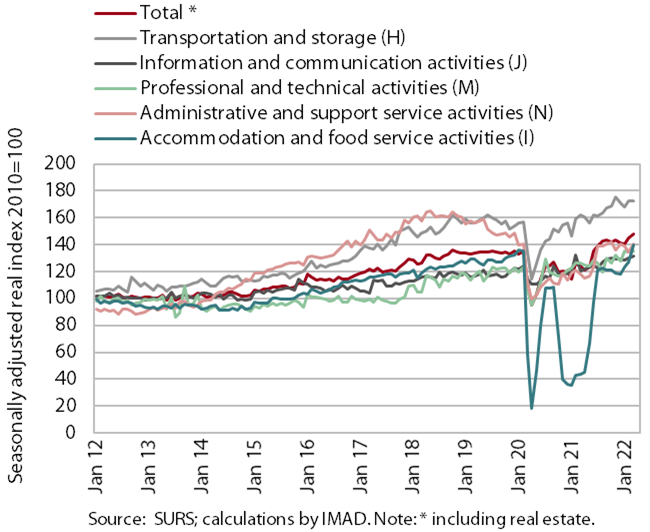
Total real turnover in market services continued to increase in the first quarter. It was up by 1.6% compared to the last quarter of last year and by 20% year-on-year given the low base in the first quarter of 2021. Current growth was strongest in accommodation and food service activities, where turnover rebounded after falling in the last quarter of 2021. Turnover continued to grow in professional and technical activities, driven by a strong accelerated growth in architectural and engineering services. Turnover growth in information and communication activities slowed due to a further decline in turnover of telecommunication services, while turnover of computer services exports increased. After high growth in the previous quarter, turnover in transportation declined slightly, this time especially in storage and postal activities. Turnover further declined in administrative and support service activities. This reflected lower turnover in all segments, with the exception of employment services, where it has mostly increased since December 2021. The lag compared to pre-epidemic turnover (Q1 2020) was only noticeable in travel agencies (by 28%).
Selected indicators of household consumption

Household consumption, which had continued to rise in the first quarter, was significantly higher year-on-year in April. Consumption growth in the first quarter was boosted by the lifting of the recovered/vaccinated/tested rule in February, further growth in compensation of employees and release of accumulated savings. Household spending was also significantly higher year-on-year in April, which is also related to the effect of last year’s lockdown in the first third of the month. Consumption for non-food products increased in April, as did, given the continued redemption of vouchers, the number of overnight stays by domestic tourists and thus the consumption for accommodation and food and beverage service activities. The already low sales of passenger cars to households continued to decline and sales of food, beverages and tobacco products were also slightly below the level of the first quarter.
Economic sentiment

The value of the economic sentiment indicator has been mostly declining since March and was lower in May among consumers and in manufacturing than a year ago. After a sharp decline in March and a temporary increase in April, the value of the sentiment indicator decreased by 1.4 p.p. in May but remained above the long-term average. On a monthly basis, confidence deteriorated most notably among consumers (by 4 p.p.), in manufacturing (by 2 p.p.) and slightly also in retail trade (by 1 p.p.). In the services sector, it remained at the previous month’s level, while in construction it was noticeably higher (by 3 p.p.). Confidence was significantly higher year-on-year in retail trade and in services (both by 10 p.p.) and in construction (by 6 p.p.). It was slightly lower year-on-year among consumers and in manufacturing (by 13 and 10 p.p. respectively). Lower confidence among consumers is related to rising prices and uncertainty about further price increases and the resulting deterioration in household purchasing power, while lower confidence in manufacturing is related to the current situation in the international environment (bottlenecks in the supply of raw materials, rising commodity and energy prices, and the Russian–Ukrainian war).
Active and inactive population
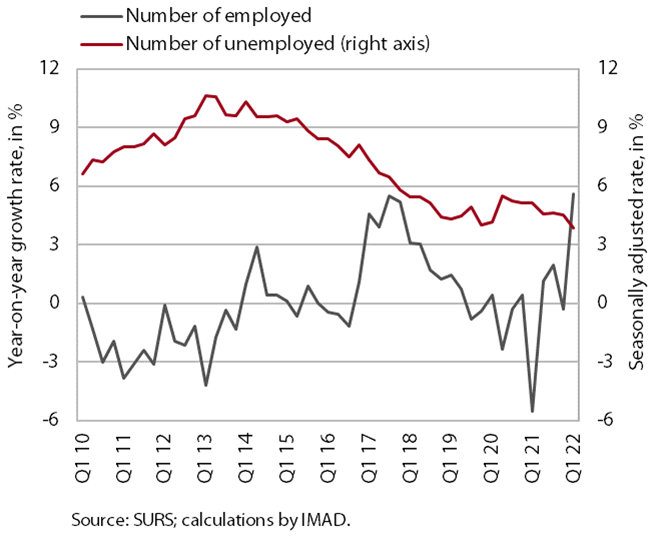
According to the survey data, the already low unemployment level fell further in the first quarter. The number of unemployed fell by 15.2% compared to the previous quarter (according to seasonally adjusted data) and by 21.4% year-on-year (according to original data). The survey unemployment rate decreased by 1.3 p.p. year-on-year, to 4.3%. At the beginning of the year, the number of people in employment increased by 5.6% year-on-year, with the volume of student work increasing by 56%, indicating a strong increase in demand for all forms of work.
Number of employed persons
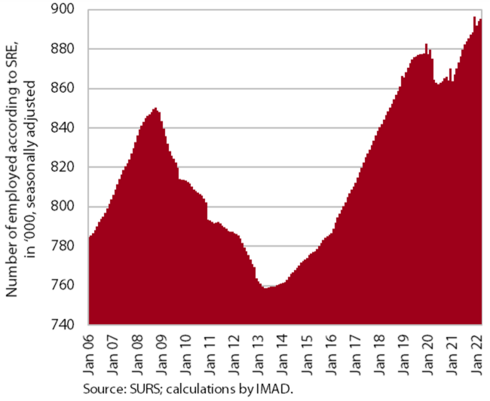
Year-on-year growth in the number of persons in employment was slightly lower in March than in the first two months of the year (2.9%). It was still very high in accommodation and food service activities and in construction. Amid economic recovery, growth in the number of persons in employment still depended largely on the employment of foreign workers, whose contribution to overall year-on-year growth was more than 50% in March. The share of foreigners among all persons in employment is also increasing, up 1.2 p.p. to 12.9% (in March 2022) over the last year. This is largely due to the shortage of domestic labour, which, given the high vacancy rates, is greatest in construction, accommodation and food service activities, and administrative and support service activities. The activities with the largest share of foreigners are construction (45%), transportation and storage (31%), and administrative and support service activities (25%).
Number of registered unemployed persons
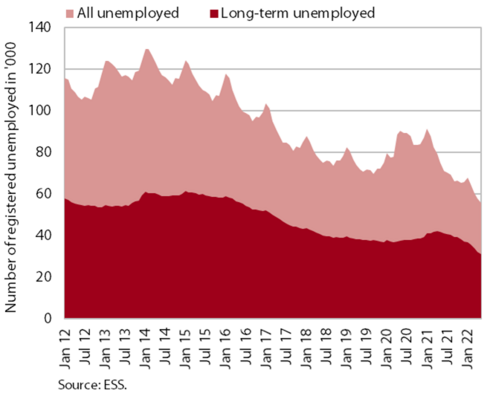
With the unemployment at its lowest level, the decline in the number of registered unemployed in May was similar to the previous two months (-2.2%), according to the seasonally adjusted data. According to original data, 55,854 people were unemployed at the end of May, 3.8% fewer than at the end of April and 25.7% fewer than a year earlier. Under conditions of high demand for labour, which is also reflected in the high vacancy rate, the number of long-term unemployed has also been declining since May last year – their number fell by a quarter year-on-year in May. Of the long-term unemployed, more than 70% have been unemployed for more than two years.
Average gross wage per employee
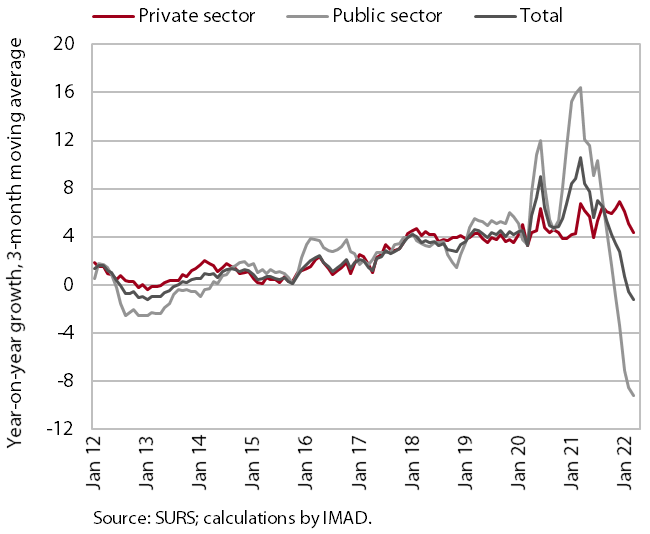
In March, average wages in the public sector were 8.3% lower year-on-year, while they were 5.6% higher in the private sector (-0.1% overall). Due to the cessation of COVID-19-related allowances, year-on-year wage growth in the public sector slowed significantly in the second half of last year and turned negative year-on-year last November. In the private sector, year-on-year growth strengthened in March due to higher extraordinary payments. Wage growth was the highest in accommodation and food service activities and it was also high in transportation and storage and in construction. In all these activities, this could already be the consequence of labour shortages.
Consumer prices
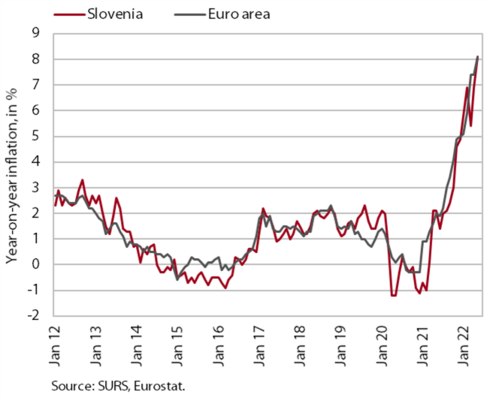
Inflation rose sharply again in April, to 8.1% year-on-year. The price increase was high across most groups of goods and services. Higher energy prices were an important contributor to year-on-year inflation. Petroleum products, whose prices increased by almost 40% year-on-year, contributed almost 2 p.p. to inflation. Prices of gas and heat energy also rose sharply (by more than 50% and 40% respectively), contributing about 1 p.p. to inflation. Electricity prices fell by about 15% year-on-year due to the temporary exemption from payment of certain charges in February (which is included in the monthly inflation rate for March), but the year-on-year decline has almost halved in the last two months due to high month-on-month growth. Higher energy and food commodity prices, which are increasingly affected by geopolitical tensions, are having a growing impact on final food prices, which rose by 11.1% year-on-year. Prices for durable goods rose by 9% year-on-year in the last two months, while prices for semi-durable goods rose by 3%. Prices for services rose by almost 5%. Of the 12 groups of goods and services, prices were lower year-on-year only in the communication group (-5.9%).
Slovenian industrial producer prices
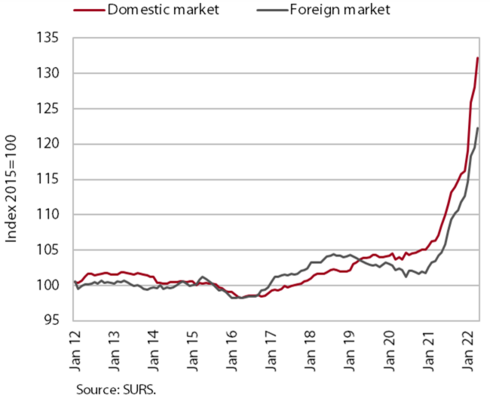
Geopolitical tensions, tighter conditions in commodity markets and supply chain bottlenecks continue to drive growth in Slovenian industrial producer prices, which reached 20.4% year-on-year in April. Price growth has increased in all industrial groups, especially in the domestic market, where it reached 23.4% year-on-year. Overall price growth continues to be driven mainly by prices of intermediate goods, which were 27.1% higher year-on-year. Energy prices continued to record the strongest year-on-year increase (more than 60%), but their contribution to overall growth was lower due to their lesser weight compared to intermediate goods. After rising by around 10% year-on-year in the first quarter of this year, the increase in prices for capital goods rose to 12.0% in April. Growth of less than 10% was only recorded by the consumer goods group, where prices for durable goods were 6.6% and for non-durable goods 8.7% higher year-on-year.
Growth in loans to domestic non-banking sectors
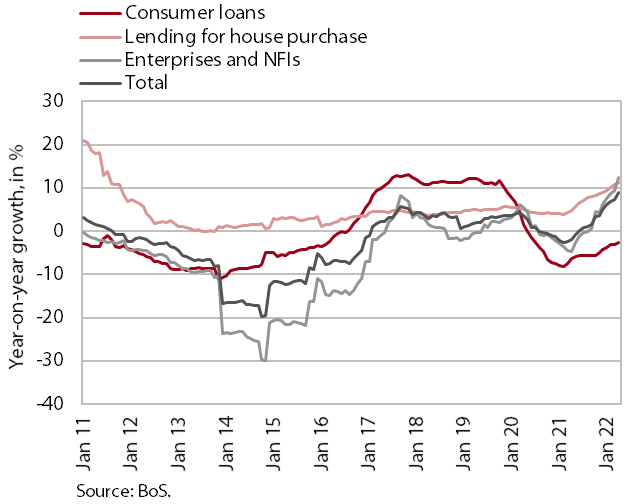
The year-on-year growth in the volume of bank loans to domestic non-banking sectors increased in the first four months of this year, reaching 9% in April. Given the growth of economic activity and favourable credit conditions, growth in corporate and NFI loans increased rapidly, reaching 12.5% year-on-year. Growth in loans to households (7.4%) has been rising at a slightly slower pace, still largely driven by growth in housing loans (11.3%). Amid solid spending, the growth of other loans to households is also increasing and the decline in consumer loans is slowing. Growth in domestic non-banking sector deposits slowed year-on-year (to 5.3%), falling more than a third short of the growth seen at the end of last year. Growth in corporate and NFI deposits and household deposits also slowed. Despite the faster growth of loans to the non-banking sector and the slower growth of domestic non-banking sector deposits, the loan-to-deposit ratio of the domestic non-banking sector is low and, at 0.71, more than 50% lower than before the 2008 financial crisis. Banks’ dependency on foreign bank financing also remains low, at just over 4% of the banking system’s total assets. The quality of banks’ assets remains solid and the share of non-performing loans was 1.2% in February.
Current account of the balance of payments
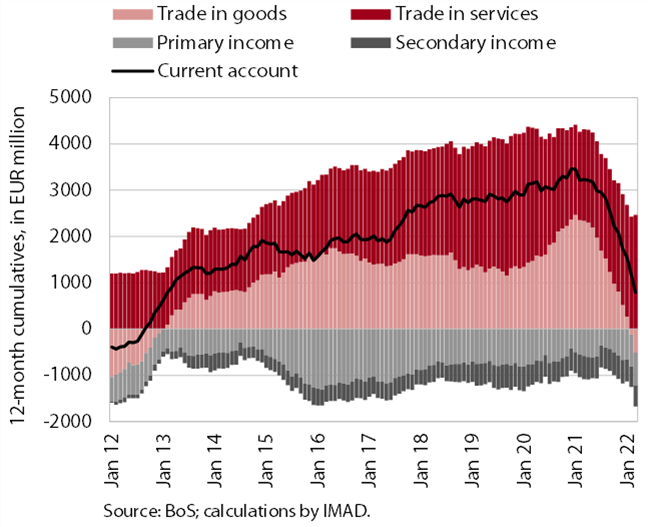
After a decade of surpluses, the current account of the balance of payments recorded a deficit in the first quarter of this year. This was mainly due to the balance of trade in goods, which turned from a surplus to a deficit as imports of goods grew faster than exports in the face of stronger domestic consumption and deteriorating terms of trade. We estimate that the deterioration in the terms of trade in the first quarter of 2022 contributed EUR 200 million to the year-on-year change in the balance of goods trade (EUR 1,030 million). Net outflows of primary income also contributed somewhat to the deficit in current transactions, mainly due to higher payments of taxes on production to the EU budget. The growth of the services surplus continued, mainly in travel and transport services. The deficit in secondary income was lower year-on-year, particularly due to lower VAT- and GNI-based contributions to the EU budget. The 12-month current account surplus on the balance of payments stood at EUR 792 million in March (1.4% of estimated GDP).
Consolidated general government budgetary accounts

The deficit of the consolidated balance of public finances was noticeably lower in the first four months of 2022 than in the same period of 2021. It totalled EUR 147.6 million in the first four months of 2022, compared with EUR 1.2 billion in the same period last year. Revenue in the first four months of this year exceeded last year’s level (by 14.3%) due to further growth in economic activity, especially domestic consumption and favourable employment growth. The high revenue growth was mainly due to VAT and corporate income tax, while revenue from excise duties declined due to measures to cushion the impact of high energy prices. Receipts from the EU budget also increased significantly, due to the inflow of funds from the Recovery and Resilience Facility and from structural funds under the 2014–2021 multiannual financial framework (MFF). Treasury transactions related to borrowing and higher income produced by assets led to higher non-tax revenues. Expenditure decreased in the first four months (by 0.9% year-on-year), reflecting lower payments related to measures to mitigate the consequences of the epidemic. These amounted to EUR 386.1 million, compared to EUR 1,186.9 million in the first four months of 2021. This led in particular to a reduction in expenditure on civil servants’ wages, transfers to individuals and households, and subsidies. On the expenditure side, investments and expenditure on goods and services have increased year-on-year.
Receipts from the EU budget
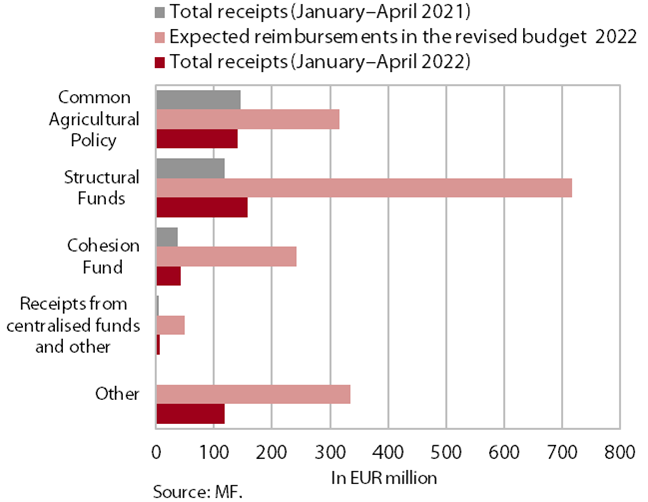
Slovenia’s net budgetary position against the EU budget was positive in the first four months (EUR 226.7 million). In this period, Slovenia’s receipts from the EU budget amounted to EUR 466.6 million (28.2% of receipts envisaged), while its payments to the EU budget amounted to EUR 239.9 million (42.6% of planned payments). The bulk of receipts (33.8% of all receipts) were funds from the structural funds, just under a third (30.2%) were funds for the implementation of the Common Agricultural and Fisheries Policy, and the lowest share (9.2%) were receipts from the EU Cohesion Fund. All reimbursed funds are part of the 2014–2020 multiannual financial framework. The second part of the advance payment, amounting to EUR 118.5 million, was paid into the budget of the Republic of Slovenia from the Recovery and Resilience Facility.
